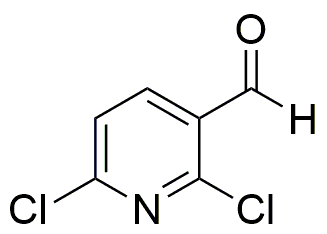2,6-Dichloro-3-pyridinecarboxaldehyde is widely utilized in research focused on:
- Synthesis of Pharmaceuticals: This compound serves as a key intermediate in the synthesis of various pharmaceutical agents, particularly in the development of anti-inflammatory and antimicrobial drugs.
- Agricultural Chemicals: It is used in the formulation of agrochemicals, including herbicides and fungicides, enhancing crop protection and yield.
- Material Science: The compound is employed in the production of specialty polymers and resins, contributing to materials with improved thermal and mechanical properties.
- Analytical Chemistry: It acts as a reagent in analytical methods for detecting and quantifying specific compounds, aiding in quality control in various industries.
- Research Applications: In academic and industrial research, it is utilized in the study of reaction mechanisms and the development of new synthetic methodologies.
Informations générales
Propriétés
Sécurité et réglementation
Applications
2,6-Dichloro-3-pyridinecarboxaldehyde is widely utilized in research focused on:
- Synthesis of Pharmaceuticals: This compound serves as a key intermediate in the synthesis of various pharmaceutical agents, particularly in the development of anti-inflammatory and antimicrobial drugs.
- Agricultural Chemicals: It is used in the formulation of agrochemicals, including herbicides and fungicides, enhancing crop protection and yield.
- Material Science: The compound is employed in the production of specialty polymers and resins, contributing to materials with improved thermal and mechanical properties.
- Analytical Chemistry: It acts as a reagent in analytical methods for detecting and quantifying specific compounds, aiding in quality control in various industries.
- Research Applications: In academic and industrial research, it is utilized in the study of reaction mechanisms and the development of new synthetic methodologies.
Documents
Fiches de données de sécurité (FDS)
La FDS fournit des informations de sécurité complètes sur la manipulation, le stockage et l’élimination du produit.
Spécifications du produit (PS)
Le PS fournit une description complète des propriétés du produit, notamment sa composition chimique, son état physique, sa pureté et les exigences de stockage. Il détaille également les plages de qualité acceptables et les applications prévues du produit.
Certificats d'analyse (COA)
Recherchez des certificats d'analyse (COA) en saisissant le numéro de lot du produit. Les numéros de lot et de lot se trouvent sur l'étiquette d'un produit, après les mots « Lot » ou « Lot de fabrication ».
Numéro de catalogue
Numéro de lot/série
Certificats d'origine (COO)
Ce certificat d'exploitation confirme le pays dans lequel le produit a été fabriqué, et détaille également les matériaux et composants utilisés et s'il est issu de sources naturelles, synthétiques ou autres sources spécifiques. Ce certificat peut être requis pour les douanes, le commerce et la conformité réglementaire.
Numéro de catalogue
Numéro de lot/série
Fiches de données de sécurité (FDS)
La FDS fournit des informations de sécurité complètes sur la manipulation, le stockage et l’élimination du produit.
DownloadSpécifications du produit (PS)
Le PS fournit une description complète des propriétés du produit, notamment sa composition chimique, son état physique, sa pureté et les exigences de stockage. Il détaille également les plages de qualité acceptables et les applications prévues du produit.
DownloadCertificats d'analyse (COA)
Recherchez des certificats d'analyse (COA) en saisissant le numéro de lot du produit. Les numéros de lot et de lot se trouvent sur l'étiquette d'un produit, après les mots « Lot » ou « Lot de fabrication ».
Numéro de catalogue
Numéro de lot/série
Certificats d'origine (COO)
Ce certificat d'exploitation confirme le pays dans lequel le produit a été fabriqué, et détaille également les matériaux et composants utilisés et s'il est issu de sources naturelles, synthétiques ou autres sources spécifiques. Ce certificat peut être requis pour les douanes, le commerce et la conformité réglementaire.


